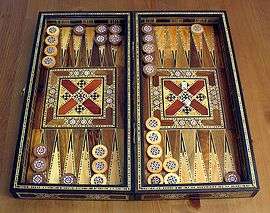Sugoroku

(from Hikone Screen)
Sugoroku (雙六 or 双六) (literally 'double six') refers to two different forms of a Japanese board game: ban-sugoroku (盤双六, 'board-sugoroku') which is similar to western backgammon, and e-sugoroku (絵双六, 'picture-sugoroku') which is similar to western Snakes and Ladders.[1]
Ban-sugoroku
Ban-sugoroku plays identically to backgammon (it even has the same starting position), except for the following differences:
- Doubles are not special. If a player rolls doubles, each die still counts only once.
- There is no "bearing off". The goal is to move all of one's men to within the last six spaces of the board.
- There is no doubling cube.
- "Closing out", that is forming a prime of six contiguous points with one or more of opponents men on the bar, is an automatic win.
The game is thought to have been introduced from China (where it was known as Shuanglu) into Japan in the sixth century.
It is known that in the centuries following the game's introduction into Japan it was made illegal several times, most prominently in 689 and 754. This is because the simple and luck-based nature of sugoroku made it an ideal gambling game. This version of sugoroku and records of playing for gambling continuously appeared until early Edo era. In early Edo-era, a new and quick gambling game called Chō-han (丁半) appeared and using sugoroku for gambling quickly dwindled.
This variant of the backgammon family has died out in Japan and most other countries, with the Western style modern backgammon (with doubling-cube) having some avid players.
E-sugoroku

A simpler e-sugoroku, with rules similar to snakes and ladders, appeared as early as late 13th century and was made popular due to the cheap and elaborate wooden block printing technology of the Edo period. Thousands of variations of boards were made with pictures and themes from religion, political, actors, and even adult material. In the Meiji and later periods, this variation of the game remained popular and was often included in child-oriented magazines. With ban-sugoroku being obsolete, today the word sugoroku almost always means e-sugoroku.
Other Sugoroku games
Many sugoroku-based video games were released, including: Kiteretsu Daihyakka: Chōjikū Sugoroku, Sugoroku Ginga Senki, Battle Hunter, Ganbare Goemon: Mononoke Sugoroku, Dokodemo Hamster 4: Doki Doki Sugoroku Daibouken!, Hello Kitty: Minna de Sugoroku, Gotouchi Hello Kitty Sugoroku Monogatari, Yu-Gi-Oh! Sugoroku's Board Game, Family Pirate Party, Hidamari Sketch: Doko Demo Sugoroku x 365, and PictureBook Games: Pop-Up Pursuit.
The video game Samurai Warriors 2 features a mini-game named Sugoroku, but it bears very little resemblance to traditional Sugoroku. Instead, it plays very much like Itadaki Street, Wily & Right no RockBoard: That's Paradise, or a simplified version of Monopoly: players take turns in moving around a board, the spaces of which are designated as different territories of Japan. By landing on an unoccupied space, the player is able to buy that space for a set amount of money. If one player lands on a space purchased by another, they must pay a fee to that player, or else can choose to challenge the player for control of that space (utilising the main Samurai Warriors 2 game engine for special challenge games). Also present on the board are "Shrine" spaces, which are roughly analogous to Monopoly's Chance and Community Chest spaces.
References
- Harvard Journal of Asiatic Studies, Vol. 1, No. 3/4. (November 1936), p. 434.
- Monumenta Nipponica, Vol. 43, No. 4. (Winter, 1988), pp. 468.
- ↑ Rebecca Salter (2006). "Japanese Popular Prints: From Votive Slips to Playing Cards". University of Hawaii Press. p. 164.
External links
| Wikimedia Commons has media related to Sugoroku. |
